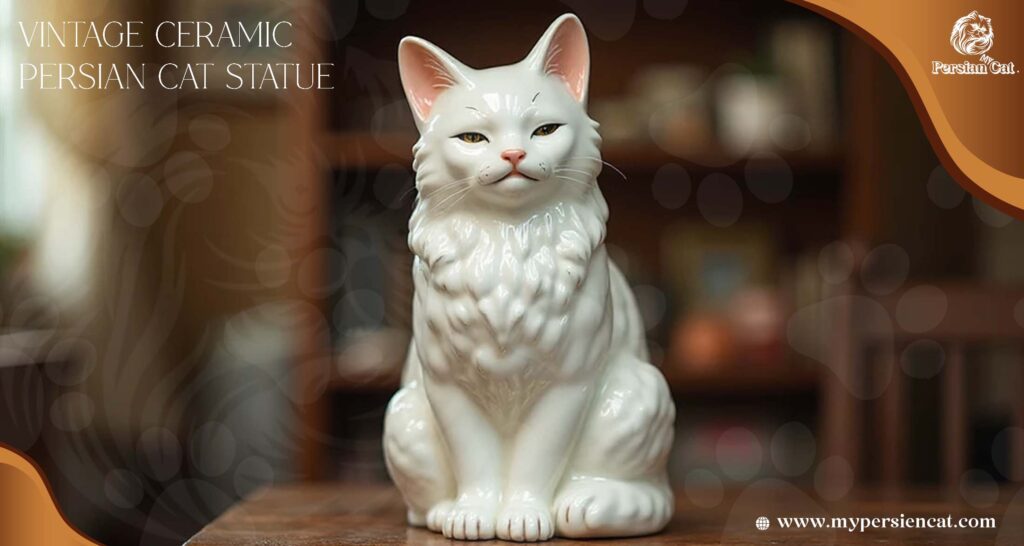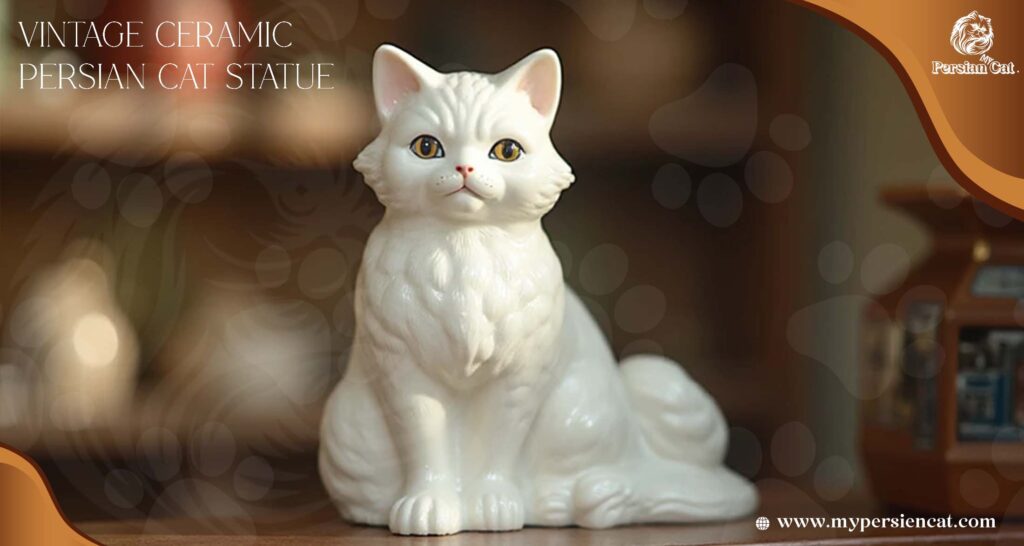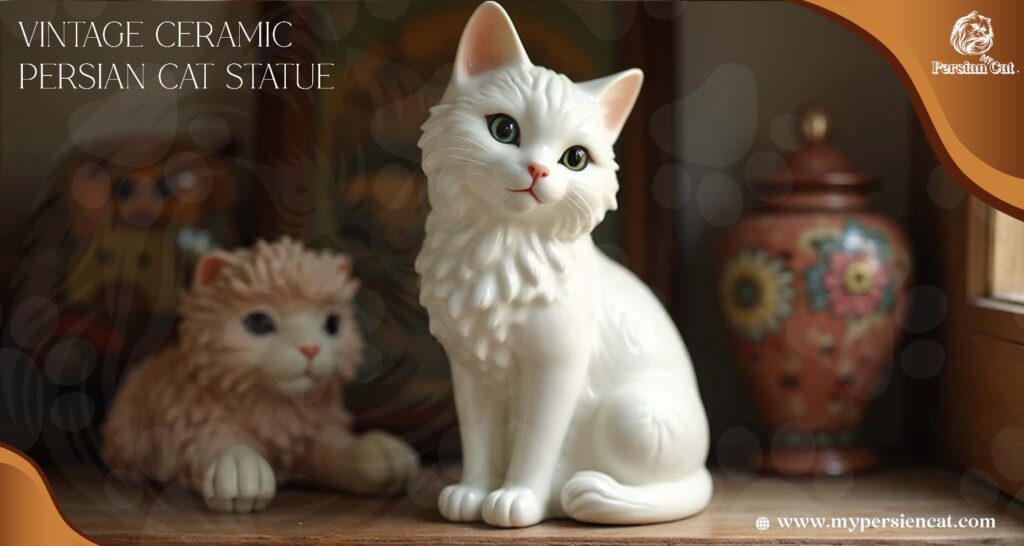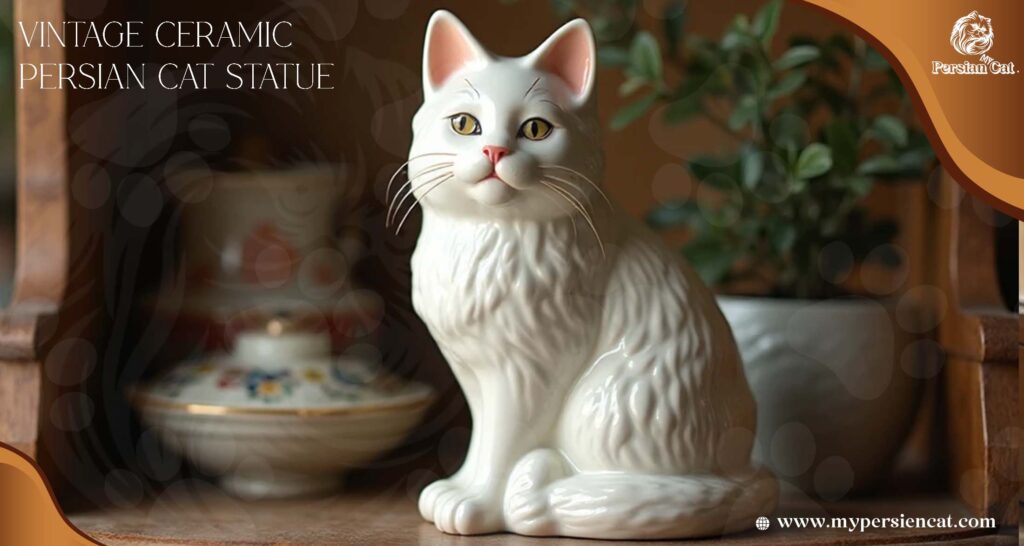Introduction
One day, I found a small ceramic Persian cat at an antique market. It caught my heart right away. The glaze was soft, the face calm, and the fur looked real. It reminded me of my first rescued Persian cat — gentle, proud, and full of quiet grace.
These vintage Persian cat statues aren’t just for show. Each one holds a story, a bit of love, and a touch of history. I’ve spent years learning about cat breeds, art, and pet adoption. Over time, I’ve seen how these statues capture the true charm of real Persian cats.
In this simple guide, I’ll help you spot an original piece, know its value, and maybe even find one that feels like it was made just for you.
What Is a Vintage Ceramic Persian Cat Statue?
A vintage ceramic Persian cat statue is more than a pretty thing. It’s a small work of art with a gentle soul. The word “vintage” means it was made many years ago, often between the 1950s and 1980s. “Ceramic” means smooth clay that has been shaped, baked, and painted by hand. When you mix both, you get something timeless — a statue that shows the calm beauty of a real Persian cat.
These statues often have a soft, shiny glaze. The fur looks real, and the eyes seem peaceful. Some are small and fit on a shelf. Others, like a large ceramic cat statue or a life-size one, can stand tall on the floor. You might see a simple white ceramic Persian cat that feels pure and classic. Or maybe a colorful “flower power” style cat from the 1970s that feels fun and full of life.
Each one has a story. Some come from old family homes, passed down with care. Others wait in antique shops, ready to be loved again. A glossy statue from Japan or a hand-painted one from Europe — each has its own charm. Together, they remind us how art, history, and love for cats can live forever in one small sculpture.

A Little History: From Real Persian Cats to Porcelain Art
It’s funny how a quiet day in an old shop can open a door to history. When I picked up my first vintage ceramic Persian cat, I had no idea I was holding a small part of art history. The smooth glaze and calm eyes came from centuries of love for real Persian cats.
Long before our modern times, artists in Europe and Asia were drawn to these elegant cats. In the 1700s, makers in Europe, like Meissen and Limoges, began crafting porcelain cats inspired by Eastern art. At the same time, artists in Japan and China were perfecting fine ceramic styles full of tiny, lifelike details. Soon, the two worlds met — soft European colors mixed with Asian skill — and the Persian cat porcelain figure was born.
Persian cats were famous for their long, silky coats and quiet charm. That made them perfect models for artists. Their round faces and gentle eyes looked beautiful in ceramic form. Even the smallest antique Persian cat statue feels alive, as if it might blink at any moment.
People also adored the Himalayan cat, which looks much like a Persian. Collectors often find both breeds in old statues — I like to call them “purr-fect twins in porcelain.” Over time, these figures became more than home décor. They turned into symbols of beauty, peace, and love for cats.
When I look at my Persian cat sculpture today, I see more than clay and glaze. I see hundreds of years of art, travel, and heart — proof that even the smallest object can hold a whole world of love and history.
My Personal Experience With Collecting (and Adopting!)
My love for vintage ceramic Persian cat statues began long before I started collecting them. It began with my first real Persian cat — a shy rescue from a local shelter. I still remember the day I brought her home. She hid behind the couch for hours. Then she peeked out, as if asking if it was safe to trust me. That small moment changed my life forever.
A few months later, I went to a flea market and saw a tiny antique cat statue. It looked just like her. The calm face and soft glaze felt like fate. I brought it home and placed it beside her favorite spot. That was how my collection began — with love and one small connection. Every Persian cat statue I’ve found since then reminds me of rescue, hope, and second chances.
As my collection grew, I learned a few lessons. Ceramic statues — especially large ones — need space and care. Just like pets, they need safe spots so they don’t fall or break. When I moved to a smaller apartment, my landlord joked and asked if all my cats were “registered.” I laughed, but it taught me something. Collecting is not only about owning things. It’s about making a home that tells your story.
These little sculptures bring peace and joy to my home. My family and kids love them too. Each one feels different. Some are bright and fun, like the colorful 1970s flower power Persian cat. Others are simple and white, calm like a quiet morning. Friends often ask where I find them. That always leads to stories about rescue, love, and how kindness and art can live together.
To me, collecting these statues feels like adopting tiny souls made of clay. Whether it’s a shiny Persian cat porcelain from Japan or a chipped figurine from a thrift shop, each one feels alive. They bring comfort, beauty, and a soft reminder — love always finds its way home.

How to Identify an Original Persian Cat Statue
Finding a real vintage ceramic Persian cat statue can feel like a treasure hunt. At first, all cat figurines may look the same. But once you know what to check, the real ones stand out right away. I learned this the hard way — I once bought what I thought was an antique, but it turned out to be a new copy. Don’t worry! With a little care and practice, you’ll soon spot the real thing with ease.
Let’s go through the simple steps that help you tell if your Persian cat statue is truly original.
🐾 1. Look for a Maker’s Mark
Turn the statue over and check the base. Real vintage pieces often have a small mark, stamp, or sticker. It might show the maker’s name, the country, or even the year.
European makers like Napco, Lefton, and Royal Doulton often used hand-stamped logos.
Japanese statues from the 1950s–1970s sometimes have red or gold foil labels that say “Made in Japan.”
Think of these marks like a cat’s pawprint — a tiny sign of pride and skill.
🐾 2. Feel the Glaze and Texture
Touch the surface gently. Real handmade ceramic cats have a soft, smooth glaze that feels silky but not slippery. The paint lines are neat and full of care. You might even see light brush strokes — proof that it was made by hand. Fake ones often look too shiny or plastic-like.
🐾 3. Study the Eyes and Fur
Real artists focus on the small things. The eyes of an authentic Persian cat statue look deep and alive. Some even have glass eyes. The fur has soft, curved lines that look fluffy and real. If the fur looks flat or stiff, it’s likely a copy.
🐾 4. Try the Weight and Sound Test
Here’s a fun trick. Tap the statue lightly with your nail or a wooden stick. Real ceramic makes a soft “ring” sound, almost like a bell. Plastic or resin gives a dull thud. Old pieces also feel a bit heavier because of the clay used years ago.
🐾 5. Check the Base
Flip the statue over. Original vintage pieces often have small signs of wear — tiny scratches or rough spots where they sat for years. Newer ones have smooth, white bottoms that look too perfect.
🐾 6. Notice the Signs of Age
Little cracks in the glaze, called crazing, are not bad. They show real age. Don’t see them as flaws — think of them as smile lines that tell a story.
🐾 7. Do a Little Research
Still unsure? Compare your statue with photos online. Check trusted sites like Etsy or eBay for vintage ceramic Persian cat statues. Read the seller’s notes about brand, time period, and condition.
Quick Tips for Beginners:
✅ Soft, lifelike eyes (not printed)
✅ Mark or signature on the base
✅ Light glaze crazing, not deep cracks
✅ Feels heavy and makes a soft ring sound
✅ Fine, hand-painted details
Learning to spot a real Persian cat statue takes time, but it’s fun and rewarding. Each find teaches you about art, history, and care. Whether it’s a European antique or a hand-painted Japanese piece, the joy of finding a true original never fades.
And here’s a small secret: once you’ve held a real one, you’ll always know the difference — like spotting an old friend in a crowd.

Are Vintage Ceramic Persian Cat Statues Worth Money?
This is the first question every new collector asks — and I totally understand why. When I bought my first vintage ceramic Persian cat statue, I didn’t think about its price. I just loved how peaceful it looked on my desk. But over time, I learned that some of these statues can be worth a lot of money — sometimes even hundreds of dollars. It all depends on the maker, the condition, and how rare the piece is.
The value of a Persian cat figurine depends on a few key things. Age is the biggest one. Statues made between the 1950s and 1970s are often the most prized. Tiny signs of age, like faint glaze cracks or faded stamps, can even add charm. Next comes the maker. Brands like Napco, Lefton, and Royal Doulton are very collectible. Japanese pieces with “Made in Japan” foil labels are also loved for their soft colors and fine details.
Condition matters too. A small chip can lower the price, while a perfect statue with its original sticker can raise it a lot. Some designs — like the bright, colorful flower power Persian cats from the 1970s — are popular for their fun, vintage style. Others, like the classic white ceramic cat, stay valuable because of their calm, timeless look.
Collectors often ask, “How much is my Persian cat statue worth?” The answer can vary a lot. Small, common pieces might sell for $20–$50. Bigger or rarer ones — like life-size statues or detailed hand-painted ones — can go for $200, $500, or more. A few antique pieces by famous makers have even sold for over $1,000!
If you want to know what your statue is worth, start online. Look at sites like eBay, Etsy, or vintage collector forums. Compare your piece to others with the same marks, size, and style. Read the seller notes to see what makes each statue special.
But here’s an honest tip: don’t collect only for the price. Collect what you love. The real value of a vintage Persian cat statue isn’t just money — it’s the story it tells. I still have one with a tiny chip from a thrift shop. It reminds me of my first rescued cat. To me, that one is priceless.
Yes, these statues can bring real cash value. But their true worth lives in the love, history, and quiet beauty they carry. Whether you find yours in a flea market, online, or in a family attic, each one holds a small piece of art history — ready to shine again.
Which Color or Design Is the Rarest (and Most Valuable)?
When it comes to vintage ceramic Persian cat statues, color can change everything. Some shades are common — soft white, cream, or light gray. Others are so rare that collectors get excited the moment they see one. I still remember finding a pale blue Persian cat statue at a flea market years ago. It looked dreamy and calm, unlike any I’d ever seen. The seller said it was made in Japan in the 1960s and that only a few existed. I didn’t think twice — I took it home that day.
Just like real Persian cats, some ceramic colors are more prized than others. The white Persian cat is the most classic and loved. Its clean, bright look never fades from style. Many older statues show this color with a glossy, soft glaze. Darker or rare tones — like smoky gray, blue, or golden cream — are harder to find. These shades were often hand-painted or made in small numbers, which makes each one special.
Collectors often say the rarest statues mix beauty with story. A colorful flower power Persian cat from the 1970s, full of bright hand-painted designs, can be just as valuable as a large ivory one. It all depends on how well it was made and how it has aged. Handcrafted pieces with smooth glaze and fine brush lines often hold more value, especially if they have a maker’s mark or artist’s signature.
So, which one is the most valuable? From what I’ve seen, statues that blend rare color with a lifelike face — especially by makers like Lefton or Napco — often sell for the most. A large pearl-white or golden cream ceramic cat in perfect shape can reach several hundred dollars.
But here’s a small secret I’ve learned over time — rarity isn’t just about color. Sometimes, a chipped statue with a kind face can touch your heart more than a flawless one. The real treasure is how it makes you feel. Whether it’s a shiny white Persian cat or a playful, colorful 1970s design, each one holds a piece of love, art, and history.

Caring for and Displaying Your Ceramic Persian Cat Collection
Taking care of your vintage ceramic Persian cat statues is like caring for real cats. A little love and attention keep them beautiful. Over the years, I’ve found simple ways to keep mine safe, shiny, and full of charm. Whether you have one small statue or a whole shelf, gentle care goes a long way.
Start with cleaning. Dust builds up fast, especially on tiny ears and fur details. Use a soft brush — an old makeup brush works great — to sweep away the dust. For a deeper clean, try a slightly damp microfiber cloth. Wipe softly. Never soak your ceramic cat in water. Too much moisture can hurt the glaze or cause small cracks. Think of cleaning it like petting a real cat — gentle and careful.
If you have pets or kids, where you place your statues matters. I once lost a small antique cat when my kitten jumped on a shelf. Since then, I’ve kept my pieces on high or inside glass cases. A sturdy cabinet or floating shelf works best. For big ones, like a life-size ceramic cat, place them on a solid surface away from busy spots. They look strong but can break with one small bump.
Now let’s talk about displaying them. Mix and match styles! A glossy white Persian beside a colorful flower-power cat from the 1970s looks amazing. Place some near plants or books for a cozy touch. If you have good light, let it shine on the glaze — it makes the statue glow.
Some collectors group by color or size. I like spreading mine around the house — one on a desk, one in the living room, maybe a tiny one by the bed. Each one adds warmth and charm, like a quiet friend keeping you company.
Caring for your statues isn’t only about cleaning and safety. It’s also about respect — for the artists who made them and the stories they hold. Every ceramic Persian cat has a history — from the maker’s brush to the first home it lived in. When you clean and care for it, you keep that story alive.
So whether your statue came from an antique shop or a flea market, treat it kindly. Dust it, admire it, and let it bring you joy. With a little care, these sweet porcelain cats don’t just decorate your home — they fill it with peace, beauty, and love.

Final Thoughts: Why These Vintage Beauties Still Melt Hearts
When I look at my vintage ceramic Persian cat statues, I can’t help but smile. Each one — from a small vintage ceramic white cat to a large ceramic cat statue — has its own story. Some remind me of my first rescued Persian. Others take me back to flea market hunts that felt like tiny adventures. These statues aren’t just pretty things. They feel alive — small, quiet companions frozen in time.
Collecting them reminds me why we love cats, real or porcelain. Each handcrafted Persian cat porcelain piece shows care, skill, and love. Every collectible Persian cat statue has a mood of its own. Some look calm and gentle. Others are full of fun and bright flower-power colors. Together, they bring warmth, joy, and a bit of old charm to any home.
The best part? You don’t need a big space to enjoy them. Start small. A single vintage ceramic Persian cat statue on a shelf or a tiny handcrafted Persian cat porcelain piece on your desk can make you smile. Enjoy the hunt. Cherish every find. Each piece is more than clay and glaze — it’s a touch of love and a piece of history.
So whether you’re just starting or have collected for years, let your statues remind you of what really matters — joy, curiosity, and the quiet beauty that softens every heart, one vintage Persian cat at a time.
About The Author
Yasin Ahmed Tusher
I Have Five Years of Experience With Persian Cat
In that time, I have learned a lot about how to care for them. Persian cats have long, soft fur, so they need to be brushed often. I know how to brush and bathe them to keep their coats clean and smooth.
I also understand what they like to eat and how to keep them healthy. Persian cats are calm and loving. I enjoy spending time with them and making sure they feel happy and safe.
I can give them medicine if needed and watch for signs of illness. I know how to care for both kittens and older cats. Taking care of Persian cats is something I do with love and care every day.
Phone : 01978040328
Fax : 001978040328
Email : info@mypersiencat.com
Vintage Ceramic Persian Cat Vintage Ceramic Persian Cat Vintage Ceramic Persian Cat Vintage Ceramic Persian Cat Vintage Ceramic Persian Cat Vintage Ceramic Persian Cat Vintage Ceramic Persian Cat Vintage Ceramic Persian Cat Vintage Ceramic Persian Cat Vintage Ceramic Persian Cat
Vintage Ceramic Persian Cat Vintage Ceramic Persian Cat Vintage Ceramic Persian Cat Vintage Ceramic Persian Cat Vintage Ceramic Persian Cat Vintage Ceramic Persian Cat Vintage Ceramic Persian Cat Vintage Ceramic Persian Cat Vintage Ceramic Persian Cat
Vintage Ceramic Persian Cat Vintage Ceramic Persian Cat Vintage Ceramic Persian Cat Vintage Ceramic Persian Cat Vintage Ceramic Persian Cat Vintage Ceramic Persian Cat Vintage Ceramic Persian Cat Vintage Ceramic Persian Cat Vintage Ceramic Persian Cat


